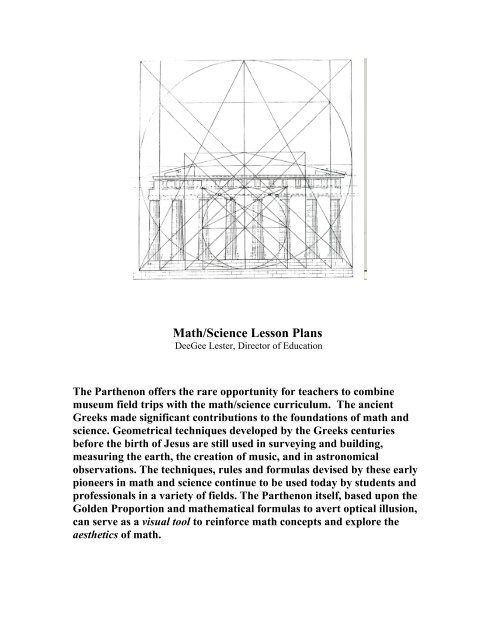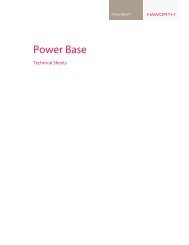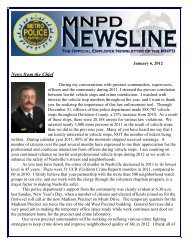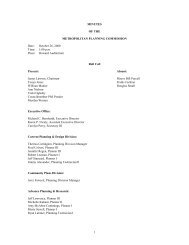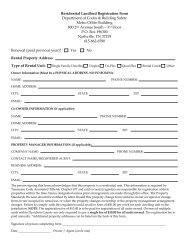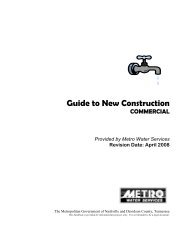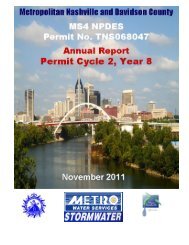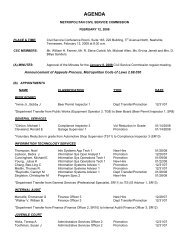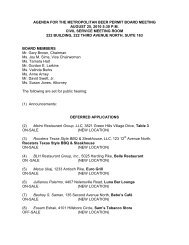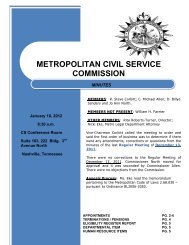Math/Science Lesson Plans - Nashville.gov
Math/Science Lesson Plans - Nashville.gov
Math/Science Lesson Plans - Nashville.gov
Create successful ePaper yourself
Turn your PDF publications into a flip-book with our unique Google optimized e-Paper software.
<strong>Math</strong>/<strong>Science</strong> <strong>Lesson</strong> <strong>Plans</strong><br />
DeeGee Lester, Director of Education<br />
The Parthenon offers the rare opportunity for teachers to combine<br />
museum field trips with the math/science curriculum. The ancient<br />
Greeks made significant contributions to the foundations of math and<br />
science. Geometrical techniques developed by the Greeks centuries<br />
before the birth of Jesus are still used in surveying and building,<br />
measuring the earth, the creation of music, and in astronomical<br />
observations. The techniques, rules and formulas devised by these early<br />
pioneers in math and science continue to be used today by students and<br />
professionals in a variety of fields. The Parthenon itself, based upon the<br />
Golden Proportion and mathematical formulas to avert optical illusion,<br />
can serve as a visual tool to reinforce math concepts and explore the<br />
aesthetics of math.
<strong>Lesson</strong> One: Exploring the Foundations of <strong>Math</strong> & <strong>Science</strong><br />
Goal:<br />
The learner will discover the contributions of the ancient Greeks to math and science.<br />
Standards: GLE.0606.1.7 through GLE 0806.1.7 (Historical context); √GLE<br />
0806.1.3 (contributions of Pythagoras); √GLE 0806.1.4 (Relate to earth and science);<br />
Algebra I: GLE.3102.1.6; Algebra II: GLE 3103.1.6; Geometry: GLE.3108.1.6;<br />
Algebra I: √3102.1.17; Geometry: √3108.1.12;<br />
Objectives:<br />
As a result of this lesson the learner will know:<br />
• The names and contributions of ancient Greek men and women to math and<br />
science.<br />
• Where each name falls in a timeline of mathematical/scientific contributions.<br />
• How the contributions of the Greeks differed and improved upon from those<br />
of earlier cultures such as the Egyptians and Babylonians.<br />
• How modern mathematical and scientific “discoveries” are traced to those<br />
ancient roots.<br />
Background:<br />
Who would be the deity for math, science, and video games? Most students know that<br />
Athena is the goddess of war and wisdom. But many do not know that Athena was also<br />
the goddess of the useful arts. According to mythology, her gifts to mankind included<br />
letters and numbers and sequential order. As goddess of the useful arts, Athena taught the<br />
skills of weaving, making pottery, and fashioning utensils, each of which requires<br />
performing a series of steps that must be carried out in a precise sequence – skills also<br />
required in working a math problem, conducting a scientific experiment, or playing a<br />
video game.<br />
(Source: Leonard Shlain, Art and Physics: Parallel Visions of Space, Time & Light (New York:<br />
Quill/William Morrow, 1991).<br />
Historically, the ancient Greeks established many of the fundamental laws and theorems<br />
in math and science. The following activities acquaint students with these contributions.<br />
1. Exploring the roots of math and science.<br />
Divide students into teams. Assign each team the task of investigating and<br />
reporting on the contributions of their individual. Below are listed several names<br />
and a brief summery of their contribution. Students should elaborate and<br />
expand on this listing by researching encyclopedias, books in the library, and by<br />
using the Internet with the name of the individual as the key word. In order to<br />
develop fundamental research skills, students should be encouraged to include in<br />
their reports a combination of these sources and not to rely solely on the Internet.
Thales of Miletus (c.630-550 B.C.)<br />
The “father of Greek mathematics,” Thales initiated the<br />
requirement of proofs.<br />
Pythagoras (c.570-490 B.C.)<br />
Greek philosopher and founder of a prestigious school,<br />
he explored the relationship of mathematics and music,<br />
developed the “theory of means” connecting math with<br />
harmony, and advanced his famous “Pythagorean Theory.”<br />
The Atomists<br />
Democritus (460-357 B.C.); Epicurus (342-270 B.C.),<br />
and Lucretius (96-55 A.D.).<br />
The Atomists advanced the notion that simple, indivisible,<br />
indestructible atoms formed the basic component of<br />
everything.<br />
Praxitiles (400-320 B.C.)<br />
Greek sculptor who devised the “8-head canon” used by<br />
sculptors in calculating human proportions for statues.<br />
Aristotle (384-322 B.C.)<br />
Scientist and one of the world’s premier philosophers,<br />
Aristotle served as tutor to Alexander the Great. His<br />
contributions include the classification of natural science<br />
and the identification and descriptions of 500 species.<br />
Euclid (3 rd century B.C.)<br />
The most famous Greek mathematician and physicist, he<br />
was author of several books including The Elements.<br />
Aristarchus (c. 310-230 B.C.)<br />
Greek astronomer who determined the sun and not the<br />
earth was the center of the universe and that the earth<br />
rotated on its axis around the sun.<br />
Archimedes (287-212 B.C.)<br />
Developed the method of exhaustion by which he was<br />
able to compute areas and volumes to any desired<br />
accuracy. His many inventions included the screw and<br />
the catapult.<br />
Erastosthenes (c. 276-195 B.C.)<br />
Greek mathematician, astronomer, and geographer who<br />
developed the technique for computing the earth’s<br />
circumference and compiled a star catalog.<br />
Apollonius of Perga (c. 260-185 B.C.)<br />
He earned the title, “The Great Geometer” and is most<br />
famous for his efforts in conic sections.<br />
Hipparchus (c. 180-125 B.C.)<br />
He was the inventor of much of the mathematical voca-
ulary. As an astronomer, he catalogued over 1,000 stars.<br />
As a geographer, he applied mathematics to the deter-<br />
mination of places on the earth’s surface.<br />
Ptolemy (100-178 A.D.)<br />
An astronomer and “Father of Modern Geography,”<br />
He devised the framework and vocabulary for geography.<br />
He also devised the principles of spherical trigonometry<br />
and astronomy.<br />
Hypatia of Alexandra (c. 370-415 A.D.)<br />
One of the first women who made a major contribution<br />
to math, she wrote a number of textbooks including<br />
On the Conics of Appolonius.<br />
While researching their individual, students should be on the lookout for fun facts,<br />
controversies, and legends that bring their mathematician/scientist to life for<br />
classmates. For example, a student team might compare the school founded by<br />
Pythagoras with Plato’s Academy or Aristotle’s Lyceum while another team<br />
might demonstrate the displacement of water that caused Archimedes to run down<br />
the road shouting “Eureka!” When presenting their reports, the spokesperson for<br />
each group might also enjoy dressing as their character.<br />
2. Make a timeline.<br />
A timeline is an excellent visual tool to help students remember and to place<br />
people and events in the order of history. (Timelines are useful with a variety of<br />
subjects –history, language arts, visual arts, etc. – and are particularly helpful for<br />
test preparation). Now that students are acquainted with Greek mathematicians<br />
and scientists, ask them to prepare a timeline including names with bracketed<br />
dates for birth and death, theorems, inventions, etc. When the class finishes ask<br />
them to look at their timeline to discover any overlapping that might indicate<br />
which mathematicians/scientists lived in the same time period and might<br />
have known each other or influenced each other’s work; who built upon the<br />
findings of an earlier scholar; whether corrections were made by one<br />
mathematician for the work/formulas/inventions of an earlier<br />
mathematician; and how an invention built upon the foundations established<br />
by an earlier invention.<br />
3. Tracing Greek advancements in math and science.<br />
The ancient Greeks were not the originators of mathematics or science. Earlier<br />
civilizations including the Egyptians and Babylonians used mathematics, simple<br />
machines, and even astronomy.
Students are familiar with the ancient Egyptians’ use of hieroglyphics<br />
(picture representations) for both writing and numerals. But even the youngest can<br />
see that the base-10 system would be complicated for making<br />
mathematical calculations beyond simple addition. For example, the<br />
hieroglyphics required for larger numbers such as 5,789<br />
requiring 29 figures! Imagine trying to write a math textbook<br />
using combinations of hieroglyphic figures. The Egyptians’<br />
may not have looked upon numbers in abstract ways,<br />
yet they came remarkably close to the Golden Ratio<br />
in their design for the Great Pyramid.<br />
The precision of Egyptian astronomical observations<br />
and calendar calculations were likewise impressive<br />
and made possible the prediction of Nile flooding.<br />
By 2000 BC, the Babylonians had devised an<br />
advanced base-60 number system. Their specialty was<br />
the creation of mathematical tables for all sorts of things.<br />
Today we have access to ancient Babylonian text<br />
providing calculations for the digging of canals with tablets<br />
showing the required number of workers, the number of days for the digging, the<br />
wages of workers, etc. As with the Egyptians, the Babylonian numerical system<br />
proved difficult to interpret, using special number symbols that look complex.<br />
In contrast to the mathematical practicality<br />
of the Egyptians and Babylonians, the Greeks began<br />
to explore the abstract qualities of mathematics.<br />
In the hands of philosophers, mathematics became<br />
an area of specialized study and argument,<br />
experimentation, and the formulation of proofs.<br />
Greeks such as Euclid, Archimedes, and<br />
Pythagoras devised rules, formulas, and theorems<br />
that are still in use more than 2,000 years later. Celebrate Pi Day!<br />
In addition, the Greeks gave the world “square” March 14th<br />
and “cube’ numbers, and portions of the Greek (keyword: Pi)<br />
alphabet (such as π and Σ) are global symbols<br />
in mathematical equations.
The Pythagorean theorem is an example of the power of “proofs” on<br />
mathematical history. Pythagoras was not the first to use the he supplied<br />
the first written proof. Crude usage dated back over 1,000 years to the<br />
Babylonians and Egyptians. a) Ask students to devise a problem proving<br />
the Pythagorean theorem. Standards √0806.1.3. b) Next, use three<br />
lengths of rope to illustrate how the ancient Egyptians constructed right<br />
triangles. Knot the ropes with units of 3, 4, and 5-knot spaces; then<br />
stretch them to form a triangle. The sum of the shortest side multiplied<br />
by itself plus the next longest side multiplied by itself should equal the<br />
longest side multiplied by itself (9+16=25). Egyptians discovered that the<br />
right triangle would always end up opposite the longest side. (See also,<br />
<strong>Lesson</strong> Plan #4 for more on Pythagorean Theorem).<br />
4 Tracing modern mathematics and scientific discoveries to their ancient root:<br />
Prime Numbers.<br />
Standards: GLE.0406.2.3 (can be added as a check for understanding since<br />
there’s not one in the standards at this level); √0506.2.1.<br />
Activity: Today’s computers can locate the largest prime numbers. (Ask<br />
students to find the definition of a prime number). However, the ancient<br />
Greek mathematician, Eratosthenes (276-195 B.C.) invented a clever way to<br />
find prime numbers. The technique is called the Sieve of Eratosthenes. Using<br />
the following directions, find the prime numbers that are less than 100.<br />
First, make a chart of numbers 1 through 100 in rows of ten (1-10, 11-20,<br />
21-30, etc).<br />
1). 1 is crossed out because it is not a prime number.<br />
2). Circle 2, which is the smallest prime number. Next cross out every<br />
2 nd number that is a multiple of 2 (4, 6, 8, etc. to 100).<br />
3). Circle 3, the next prime number. Now cross out every third number,<br />
all multiples of 3 (6, 9, 12, 15, etc. to 100). Some such as 6 and 12 will<br />
already be crossed out since they are multiples of 2).<br />
4). Circle the next open number, 5 and again cross out every 5 th number.<br />
(Some will already be crossed out and students will notice there are<br />
few open numbers remaining).<br />
5). Continue the process until all the numbers up to 100 are either<br />
crossed out or circled as prime numbers.
Activity: Students should be invited to explore other ties between<br />
modern scientific or mathematical discoveries and their ancient roots.<br />
Examples include but should not be limited to the following:<br />
a) The Archimedean screw and how it is used today in waste treatment<br />
plants. See if your community uses this devise to pump wastewater or<br />
explore a web site such as the following:<br />
www.mcs.drexel.edu/crorres/Archimedes/Screw/Applications.html<br />
b) (High School level): Review the ancient Greek scientists and<br />
mathematicians listed above and locate the Atomists. Describe their<br />
theory and the later theories and models including the 1913<br />
Rutherford-Bohr Planetary Model of the Atom and the 1924 Neils<br />
Bohr-Louis de Broglie Model of the Atom. How has atomic research<br />
and theory evolved in the 20 th century?<br />
C. Ask students to research a unique geared device, The Antikythera Mechanism<br />
(Nature Magazine, issue #444, 30 November, 2006). This second century BC<br />
Greek box, discovered in a shipwreck in 1901 appears to be a technologically<br />
complex machine that calculated, displayed, and predicted celestial activity such<br />
as lunar and solar eclipses and was, in effect, the world’s first analog computer<br />
designed over 2000 years ago. Following years of research, surface-imaging, and<br />
high resolution X-ray tomography of device fragments, archaeologists, scientists,<br />
and computer experts were able to decipher the inscriptions and reconstruct the<br />
complex geared functions that allowed ancient Greeks to track cycles within our<br />
solar system with amazing accuracy.<br />
Invite students to explore this amazing ancient device through journals<br />
such as Nature (listed above) or Scientific American (June 1959) as well as<br />
through Internet sources (keyword: Antikythera Mechanism.
<strong>Lesson</strong> Two: Simple Machines<br />
Goal:<br />
The learner will understand that the Ancient Greeks developed a very advanced<br />
civilization that continues to influence our lives in many ways.<br />
Standards: GLE.0806.1.7; CLE.3102.1.6; CLE.3103.1.6; CLE.3108.1.6.<br />
Objectives:<br />
As a result of this lesson, the learner will:<br />
• Be able to identify six simple machines<br />
• Know how simple machines can lessen the effort needed to do a job.<br />
• Know how simple machines work.<br />
• Know how simple machines helped to build the Parthenon.<br />
• Partner with a classmate and research the Internet to choose a simple machine<br />
to make.<br />
• Create a project notebook.<br />
Activities: (Incorporating math, science, history, art, and architecture)<br />
1. Defining and identifying simple machines<br />
A simple machine is a tool with few or no moving parts. Simple machines<br />
date back to antiquity and were used in everyday tasks and in the construction<br />
of buildings, monuments, and even irrigation systems. The pyramids, the<br />
Parthenon, and the Roman aqueducts are all the products of simple machines.<br />
The simplicity of these machines and the common need for tools that would<br />
be easy to make and handle, means that even remote societies invented and<br />
used similar objects.<br />
Identify six simple machines:<br />
Lever: A lever is a simple machine consisting of a rigid body such as a<br />
board or metal bar resting on a turning point called a fulcrum. The weight to<br />
be moved or lifted is called a load. Ask students to draw an example of a<br />
lever in action (such as a board lifting a large rock, a hammer pulling a<br />
nail from a board, or two children playing on a seesaw). In each picture<br />
students should identify the lever (L), the fulcrum (F), and the load or weight<br />
(W).<br />
Inclined Plane: An inclined plane is a flat surface that is higher on one<br />
end to ease the effort in moving a load from one level to another. Ask<br />
students to draw an example of an inclined plane (a ramp, a slide, or a<br />
slanted road). In each picture students should identify the inclined plane (I)<br />
and the load or weight (W). An inclined plane can be used to move objects up<br />
to a higher level or down to a lower level. Which direction is easier?<br />
Wedge: A wedge is made up of two inclined planes that meet and form a<br />
sharp edge. The wedge is used to split two objects apart when pressure or
force is applied. Ask students to draw an example of a wedge (a knife,<br />
fork, nail or ax). In their drawings children should show how applied force<br />
(F) to the wedge (W) splits the object (O).<br />
Screw: A screw is also made from an inclined plane, but this time the<br />
inclined plane winds around itself. A screw can hold objects together or be<br />
used to raise or lower solids or liquids such as water from one level to another.<br />
Ask students to draw an example of a screw (a jar lid, light bulb, or a car<br />
jack).<br />
Wheel and Axle: An axle is a rod that goes through a wheel allowing it to<br />
turn more easily. This simple machine allows us to roll things from place to<br />
place. Ask students to draw a picture of a wheel and axle (a car, roller<br />
skates, or door knob).<br />
Pulley: A pulley combines a wheel and a rope to create a simple machine<br />
capable of lifting a heavy load. The rope fits into a groove in the wheel with<br />
one end of the rope attached to the load. When you pull the other end of the<br />
rope, the load is lifted. Ask children to draw an example of a pulley (the<br />
mechanism that hoists the flag on a flag pole, a construction crane or the<br />
apparatus that raises window blinds).<br />
2. Associating simple machines with construction of the ancient Parthenon.<br />
Remember that the Parthenon was built 438 years before the birth of<br />
Jesus and constructed on top of the Acropolis, the highest point in<br />
Athens, rising approximately 200 feet above the city. The Greeks<br />
quarried marble from Mount Pentelicon and transported the marble<br />
approximately ten miles to the Acropolis. Ask students to look over the list<br />
of simple machines (lever, inclined plane, wedge, screw, wheel & axle, and<br />
pulley) and determine which machines would be used to construct the ancient<br />
temple and how those machines were used in cutting, transporting, and lifting<br />
the marble.<br />
3. Creating a project notebook<br />
Students may work individually or in teams to make an example of a simple<br />
machine (such as a pulley, wheel & axle, etc) to demonstrate to the class. In<br />
addition, students may create a project notebook including directions for<br />
construction of their simple machine, along with definitions and examples<br />
(drawings or magazine pictures) of the six types of simple machines and their<br />
answers to the question in activity #2.
<strong>Lesson</strong> Three:<br />
<strong>Math</strong>ematical Calculations: The Source of Parthenon Beauty<br />
Goal:<br />
The learner will discover the relationship between mathematics and the aesthetic beauty<br />
of the Parthenon.<br />
Standards: GLE 0806.1.7; √3102.1.6; √3103.1.6; √3108.1.6.<br />
Objectives:<br />
As a result of this lesson the learner will know:<br />
• The significance of the Golden Rectangle in regard to aesthetic appeal.<br />
• How the Greeks used math in overcoming problems with optical illusion.<br />
• The importance of balance and symmetry in building design and sculpture.<br />
• How math calculations contributed to the aesthetic appeal of the Athena<br />
sculpture.<br />
Background:<br />
The ancient Greeks would love the dynamics of modern math, science, and<br />
technology – the computer, the split-second communications of the Internet and the cell<br />
phone, and the research into complex DNA. They would be especially excited by our<br />
“Golden Age of Astronomy” as mathematical calculations figure prominently in every<br />
aspect of today’s space age – from launching the space shuttle and making adjustments to<br />
the Hubble Telescope to exploring new solar systems and black holes. All these advances<br />
reinforce the notions of the Greek philosopher and mathematician, Pythagoras. His<br />
philosophy was distinguished by its description of Reality in terms of arithmetical<br />
relationships. Pythagorean mathematics had tremendous influence on the famous Greek<br />
philosopher Plato who, along with his followers at the Academy, believed that a study of<br />
mathematics held the key to all understanding. Carved above the doorway leading into<br />
the Academy of Plato (423-348 B.C.) were these words: Let no one ignorant of Geometry<br />
enter here.”
To the ancient Greeks, it was not numbers themselves that were important as the<br />
Egyptians and Babylonians believed, but the relationship between the numbers. These<br />
relationships were known as ratios and proportions. Through experimentation and the<br />
careful analysis and proof of findings, the ancient Greeks had already proven connections<br />
between math and nature, math and music, math and conceptual judgement. For example,<br />
a comparison of two things (mother:father, water:air, dog:cat) that we learn as babies is<br />
the most basic process of intelligence and the elementary basis for conceptual judgment,<br />
or how we figure things out. This comparison of two different things or ideas or<br />
quantities is a ratio or a measure of difference expressed in the formula a:b or a is to b.<br />
A proportion is more complex because it is the relationship equivalency between<br />
two ratios, or one element is to the second element as the second element is to the third. It<br />
is more subtle and profound than the simple difference in a ratio and is known in Greek<br />
thought as an analogy. Students should keep these mathematical terms in mind as they<br />
explore characteristics of Greek architecture, especially their reliance upon the Golden<br />
Rectangle (also referred to as the Golden Proportion) and optical illusion in designing<br />
and constructing the ancient Parthenon.<br />
Activities:<br />
The following exercises meet the following standards:<br />
1. The Golden Rectangle or Golden Proportion<br />
Standards GLE.0606.4.; GLE.0706.4; √can be used as check for<br />
understanding since there’s not one in the standards for golden<br />
proportion.<br />
The Greeks also saw the relationship between math and beauty and<br />
proved their theory that geometry is a way to create beauty and to give the<br />
illusion of perfection. These early mathematicians observed many<br />
proportional relationships in the natural world. One proportion that
appears most often is the Golden Proportion. It is the ratio between two<br />
dimensions of a plane figure or the divisions of a line such that the smaller<br />
is to the larger as the larger is to the sum of the two, represented by the<br />
ratio 1:1.618 or roughly 3 to 5 or 4 to 9. The ancient Greeks considered<br />
this to be the perfect proportion and it shows up in nature as the golden<br />
spiral (evident in natural objects ranging from sea shells to pine cones)<br />
and the golden rectangle which figures prominently in ancient<br />
architecture, especially the Parthenon. The foundation of the Parthenon is<br />
composed of two golden rectangles corresponding with the two rooms of<br />
the building.<br />
Describe the Golden Proportion as it relates to the Parthenon.<br />
(The ratio of the two rooms whereby the smaller is to the larger as the<br />
larger is to the sum of the two rooms.) The exterior of the Parthenon<br />
likewise fits into the golden proportion so that the ratio of the entablature<br />
(the area from the top of the columns to the top of the roof) is to the<br />
column as the column is to the sum of the two. The same proportion<br />
appears again inside the Naos that houses Athena. The double decking of<br />
columns surrounding the stature adds to the scale of the statue through the<br />
golden proportion whereby the top column is to the lower as the lower<br />
column is to the sum of the two.<br />
Make a Golden Rectangle:<br />
Construct a Square (A, B. C. D with A & B at the top left and right<br />
and D & C at the lower left and right).<br />
Mark E as the midpoint between DC.<br />
From midpoint E, draw a diagonal line to B.
Extend the line DC so that the vertical line BC is the midpoint of<br />
EF.<br />
Using a compass anchored at E, swing an arc from B to F.<br />
Extend a vertical line from F to G; then extend the line AB to G.<br />
You have a Golden Rectangle.<br />
2. Optical Illusion<br />
<strong>Math</strong>ematical theories and computations were crucial to the<br />
illusion of perfection that sets apart the Parthenon from other architectural<br />
structures. An optical illusion is often the result of our eye structure<br />
(specifically, the curvature of the retina), oscillation as our eyes shift<br />
between two figures, or tricks played by our minds. In constructing the<br />
Parthenon the ancient Greeks understood that the straight lines on<br />
buildings, when viewed from a distance, often appear to curve in<br />
unintended directions. In their efforts to construct a visually perfect<br />
building, the ancient Greeks calculated and made architectural<br />
adjustments. The three most important are:<br />
Curvature of the horizontal lines<br />
Inclining of vertical lines<br />
Slight bulge, or entasis of the columns.<br />
They knew, for example, that straight, horizontal lines, such as the<br />
floor or ceiling, often appear to sag when viewed from a distance. To<br />
compensate, they constructed these lines on a curve – higher in the center<br />
and curving down on the ends.<br />
They also understood that vertical lines, such as walls and<br />
columns, could appear to lean outward from the building. To compensate<br />
for this illusion, the Greeks made all vertical lines tilt in slightly.<br />
Likewise, the entasis provided a third source of curvature to the lines of<br />
the building.<br />
Other architectural refinements included minute adjustments in the<br />
setting of metopes and triglyphs, and the alignment and setting of<br />
columns. Through mathematical calculation and careful measurement to<br />
determine the exact degree of curvature, the Greeks assured these slight<br />
architectural adjustments created the graceful lines and illusion of<br />
perfection that make the Parthenon an architectural wonder.<br />
Field Trip Observation Activity:<br />
Look closely at the building during your field trip. How many<br />
of these refinements can you spot? Where must you be standing in<br />
order to detect these architectural adjustments? These architectural<br />
refinements contribute to the illusion of what image as one looks down<br />
the row of columns on the porches?
3. Spatial Sense and Geometric Concepts<br />
Standards: GLE 0606.1.1 (math language); GLE 06061.7 through<br />
GLE 0806.1.7 (connection with real world); GLE 0806.3.5 (slope).<br />
As mentioned earlier, the ancient Greeks’ constant striving for balance,<br />
symmetry, and perfection was reflected in all aspects of their art,<br />
architecture, public lives and personal fulfillment. Balance and symmetry<br />
were considered the hallmark of perfection. For example, in the personal<br />
live the goal was a perfect balance of intellectual, physical, and spiritual<br />
development. This is reflected in their use of gymnasiums as not merely a<br />
place to “work out” physically, but as a place for study and participation in<br />
intellectual discussion with the great philosophers. The art and architecture<br />
also reflected this desire for perfect balance and symmetry. Take a<br />
moment to discuss what these words mean to you. Balance is the<br />
combining of elements to create equilibrium. Symmetry is the<br />
arrangement of parts on opposite sides of a boundary so that the two<br />
halves are identical or mirror images. Following your field trip to the<br />
Parthenon in <strong>Nashville</strong>, discuss the building’s architecture and details
including the Pediments, Friezes, and Athena Statue. How do each of<br />
these reflect balance and symmetry?<br />
4. Proportion in the Athena Statue<br />
Praxitiles was a fourth century BC Greek sculptor of great<br />
reknown. He is credited with developing the 8-head canon by which<br />
schulptors figure the proportions of the human body. This canon states that<br />
the size of the human body may be measured accurately and conveniently<br />
using the head size as a standard unit. With this measure, the adult body is<br />
approximately 8 heads tall. Alan LeQuire, sculptor of the <strong>Nashville</strong><br />
Athena statue states, “It works for me. My head is 9” tall from chin to the<br />
top of the head and I am 6’ (or 72” tall). 8x9=72.”<br />
As the ancient Greeks understood, distance can produce optical<br />
illusions that in art and architecture force the adjustment of lines in order<br />
to achieve the appearance of perfection. As we stand in the Naos and<br />
admire Alan LeQuire’s sculpture of Athena, what our eye sees is a<br />
perfectly proportioned figure. But, like the ancient Greeks, Alan<br />
understood that wherever we sit or stand in the Naos, we are looking at the<br />
41’10” statue of Athena from a weird angle. In order to achieve the<br />
illusion of proportional perfection in his statue, Alan had to make<br />
adjustments to the sculpture. In other words, he turned to math. Lets look<br />
at just one of his adjustments: the size of Athena’s head. We have already<br />
explored the 8-head canon used in sculpting human figures. Alan<br />
understood that in order to achieve the illusion of perfection, he would<br />
have to increase the head size of Athena. Beginning with the 41’10”<br />
statue, he subtracted the 5 ft. base and the 4 ft. helmet, leaving 32’10” for<br />
the head and body of Athena.<br />
A) Now convert 32’10” into inches.<br />
B) By dividing these inches by 8, you’ll get the size of Athena’s head<br />
according to the 8-head canon.<br />
C) In order to increase the head size, divide the total number in “A”<br />
by 7 to give you the actual size of the head on the statue.<br />
<strong>Lesson</strong> Four: Measurements and Calculations<br />
Goal: The learner will use practical skills to solve problems relating to the <strong>Nashville</strong><br />
Parthenon.<br />
Objectives:<br />
As a result of this lesson the learner will:<br />
• Identify geometric shapes, orders or patterns on the Parthenon’s exterior or<br />
interior.<br />
• Determine the circumference of Athena’s shield.<br />
• Determine the number of rotations necessary to roll the shield from its current<br />
location in the Naos to the doors.<br />
• Display an understanding of the Pythagorean Theorem.
• Estimate the number of degrees in an obtuse angle.<br />
• Determine the density of one of the bronze doors.<br />
• Solve an ancient mathematical riddle.<br />
Activities:<br />
1. Identifying Shapes and Patterns<br />
Using your Parthenon field trip, photographs of the Parthenon, or<br />
diagrams of the Doric and Ionic Orders, locate the following shapes,<br />
order, or patterns on the Parthenon’s exterior and interior:<br />
A Circle____________ A Triangle_______________<br />
A Square _______________ A Rectangle _____________<br />
Greek Key Pattern____________ Egg & Dart Pattern________<br />
Ionic Capital _____________ Doric Capital ____________<br />
(Note: If you are using photos, look in the dictionary for examples of<br />
unfamiliar patterns such as the Greek Key or the Egg and Dart Pattern<br />
before answering the question).<br />
A volumetric shape is a three-dimensional version of a two-dimensional<br />
shape. For example, a ball or sphere is a volumetric version of a circle.<br />
Can you name the volumetric versions of the following shapes: a square, a<br />
rectangle, a triangle? Can you locate volumetric shapes in the Parthenon?<br />
Standards:√0406.4.21; √0406.4.17.<br />
2. Determining Circumference.<br />
Pi (π) is the sixteenth letter of the Greek alphabet. It is approximately<br />
3.14159 representing the ratio of the circumference to the diameter of a<br />
circle. Let’s figure the circumference of Athena’s shield that has a<br />
diameter of 15 ft. using the formula, Circumference =diameter x π.<br />
Standards: GLE.0406.4.1, GLE.0406.4.2; GLE.0406.4.3; √0606.4.12;<br />
√0606.4.13.<br />
3. Determining Rotations:<br />
Which number (diameter or circumference) would be necessary in<br />
determining how many rotations it would take to roll Athena’s shield from<br />
its present location to the east door of the Parthenon? Now, write a<br />
formula for the problem with the distance being 65’47”. How many<br />
rotations would be required to roll the shield to the door?<br />
Standards: √0606.4.16.<br />
4. Pythagorean Theorem:<br />
Standards: GLE 0806.1.7; √0806.1.3; GLE 0806.4.1; √0806.4.1;<br />
√0806.4.2; spi 0806.4.1; spi 0806.4.2.<br />
The Pythagorean Theorem states that the sum of the squares of the<br />
lengths of the sides of a right triangle is equal to the square of the length<br />
of the hypotenuse. Now let’s consider the huge bronze doors of the<br />
<strong>Nashville</strong> Parthenon: the opening of the entire doorway is 14’ with each
door measuring 7’ across, 24’ tall and weighing 7.5 tons. On your field<br />
trip to the Parthenon, note the semi-circular arc that forms a track in the<br />
floor at each door. By opening a door to the center of the art we form a<br />
right angle with the opening. Each side of the right triangle is 7 ft. Using<br />
the Pythagorean theorem, find the length of the hypotenuse.<br />
Pythagorean Baseball:<br />
www.pbs.org/wgbh/nova/proof/puzzlw/baseball)<br />
Standards: GLE.0806.4.1; √0806.4.1; √0806.4.2; √0806.1.3;<br />
spi.0806.4.1; spi.0806.4.2.<br />
5. Estimate Angles:<br />
During your Parthenon field trip, you will see a model of a crane in the<br />
lower lobby near the video. It is roughly the shape of an obtuse angle. An<br />
obtuse angle is an angle greater than 90 degree and less than 180<br />
degrees. Use the spokes on the crane to estimate the number of degrees in<br />
the obtuse angle.<br />
6. Solve an Ancient Riddle:<br />
We do not know when Greek mathematician Diophantus lived (sometime<br />
between 100 and 400 A.D.). But thanks to a riddle created by an admirer,<br />
we know the age of Diophantus when he died. If you think computer<br />
games are challenging, try to solve this riddle to find his age at death.<br />
Diophanus’ youth lasted 1/6 of his life. He grew a beard after 1/12<br />
more of his life. After 1/7 more of his life, Diophantus married.<br />
Five years later he had a son. The son lived exactly ½ as long as<br />
his father, and Diophantus died just four years after his son’s<br />
death. All of this totals the number of years Diophantus lived.<br />
(Hint: Review of fractions will be helpful here:<br />
(1/6)n +(1/12)n +(1/7)n +5 + (1/2)n +4 =n<br />
Sources and Reading Suggestions:<br />
Books:<br />
A great place to start in firing up young students’ enthusiasm for math is with the<br />
collection of books by Theoni Pappas (World Wide Publishing/Tetra).<br />
• The Adventures of Penrose the <strong>Math</strong>ematical Cat (1997). In story form, this delightful<br />
book introduces children to math concepts. Even the table of contents ignites the curiosity of<br />
young readers: “Penrose meets the fractal dragon”; Penrose discovers the mathematics of soap<br />
bubbles”; “Penrose solves the case of the missing square”; to name a few.<br />
• The Further Adventures of Penrose (2004).<br />
• <strong>Math</strong> Talk: <strong>Math</strong>ematical Ideas in Poems for Two Voices (1991). This brilliant
integration of math and language arts brings verbal learners and imaginative young minds<br />
to a new appreciation for mathematics. It makes a great participatory introduction to math<br />
at the beginning of the school year.<br />
• The Music of Reason: Experience the Beauty of <strong>Math</strong>ematics Through Quotations<br />
(1995). Quotations introduce students to math and imagination, math and the arts, math and<br />
history, math and humor, and math and infinity, to name a few of the topics.<br />
• Franctals, Googles, and Other <strong>Math</strong>ematical Tales (1993). What student could resist a<br />
math book with chapter titles such as “Leonhard the Magic Turtle” (topology and networks);<br />
“Penrose Meets Lo Shu” (magic squares); or Doctor Spacemath,” (logic problems).<br />
• The Joy of <strong>Math</strong>ematics: Discovering <strong>Math</strong>ematics All Around You (1986)<br />
• More Joy of <strong>Math</strong>ematics (1991)<br />
• The Magic of <strong>Math</strong>ematics 1994) This trio of books introduces children to the many ways<br />
math can be enjoyed and appreciated through wonderful examples, games, and puzzles that make<br />
math concepts relevant to their lives.<br />
• <strong>Math</strong> Footprints: Discovering <strong>Math</strong>ematical Impressions All Around Us (1999).<br />
From weather to architecture, this book makes students aware that they are surrounded by math.<br />
• <strong>Math</strong>-A-Day Calendar (published annually). Explore a mathematical concept, challenge,<br />
or puzzle each day with your students.<br />
Some other great choices:<br />
• Measure Up! A Bug Contest by Frank Wilson (2003). A wonderful book for early<br />
elementary, especially appealing during Olympic years.<br />
• Exploring <strong>Math</strong> With Books Kids Love by Kathryn Kaczmanski (1998). Combines<br />
math and language arts to explore math concepts through popular children’s lit.<br />
• A Passion for <strong>Math</strong>ematics: Numbers, Puzzles, Madness, Religion, and the Quest<br />
for Reality by Clifford A. Pickover (2005).<br />
• Vision in Elementary <strong>Math</strong>ematics by W.W. Sawyer (2003 edition of 1964<br />
classic).<br />
High School level:<br />
1. Bernal, J.D. A History of Classical Physics (NY: Barnes & Noble Books, 1972).<br />
This high school level book provides a brief, but excellent historical background for mathematics.<br />
2. Clagett, Marshall. Greek <strong>Science</strong> in Antiquity (Mineola, NY: Dover Publications,<br />
Inc., 2001 ed.). A high school level exploration of the origins and development of Greek<br />
scientific theory – an easy read for those without scientific backgrounds.<br />
3. Darling, David. The Universal Book of <strong>Math</strong>ematics: From Abracadabra to<br />
Zeno’s Paradoxes (Hoboken, NJ: John Wiley & Sons, Inc., 2004). This book is and<br />
easy to use <strong>Math</strong>ematics dictionary and a great resource for teachers and students.<br />
4. Hambridge, Jay. The Parthenon and Other Greek Temples: Their Dynamic<br />
Symmetry (New Haven: Yale University Press, 1974). Out of print and difficult to find,<br />
this book would be useful for students interested in architecture and engineering of the Parthenon.<br />
5. Huntley, H.E. The Divine Proportion: A Study in <strong>Math</strong>ematical Beauty (Mineola,<br />
NY: Dover Publications, Inc., 1970). High school/college level book exploring aesthetics<br />
and universal order. A heavy, but wonderful read with exercises.<br />
6. Klein, Jacob. Greek <strong>Math</strong>ematical Thought & the Origin of Algebra (Mineola,<br />
NY: Dover Publications, Inc. 1992). The development and impact of Greek number<br />
concept, mathematical thought, and achievement.
7. Livio, Mario. The Golden Ratio: The Story of Phi, The World’s Most Astonishing<br />
Number (New York, NY: Broadway Books, 2003). An interesting and beautifully<br />
written book demonstrates, better than most, the integration of mathematics into all aspects of<br />
human history through the evolution of phi. This would be a great book combining mathematics<br />
with language arts, visual arts, and world history.<br />
8. Mlodinow, Leonard. Euclid’s Window: The Story of Geometry from Parallel<br />
Lines to Hyperspace (NY: A Touchstone Book, 2001) Another wonderful book<br />
integrating math with language arts and world history as the reader travels through five<br />
revolutions in geometry. It is funny, cleverly written, and a dramatic story.<br />
9. Schimmel, Annemarie. The Mystery of Numbers (New York: Oxford University<br />
Press, 1993). This delightful book explores numbers through a revealing look at their meaning<br />
and use in folk lore, literature, symbolism and superstition throughout history and across<br />
cultures.<br />
10. Shlain, Leonard. Art & Physics: Parallel Visions of Space, Time & Light (NY:<br />
Quill/William Morris, 1991). This book, along with Simon Shama’s The<br />
Power of Art, reveals the amazing foreshadowing of scientific breakthrough<br />
by visionary artists throughout history. A wonderful integration of science<br />
and the visual arts with world history and a great way for teachers in these<br />
specialized areas of study to demonstrate to students how the movement of<br />
history weaves together these diverse ideas and visions.<br />
Web Sites:<br />
1. www.perseus.tufts.edu/Greek<strong>Science</strong>/Students/Mike/geometry.html.<br />
2. www.coe.uh.edu/archive/science/science_lessons/scienceles1/finalhome.htm<br />
3. www.groups.dcs.st-andrews.ac.uk/~history/<strong>Math</strong>ematicians/Euclid.html<br />
4. www.groups.dcs.st-andrews.ac.uk/~history/<strong>Math</strong>ematicians/Ptolemy.htl<br />
5. www.math.utah.edu/~alfield/Eratosthenes.html<br />
6. www.aleph0.clarku.edu/!djoyce/java/elements/html<br />
7. www.home8.swipnet.se/~w80790/Works/Hypatia.htm<br />
8. www.saitjoe.edu/~shf3124/Pythagoras.html<br />
9. www.groups.dcs.standrew.ac.uk/~history/HistTopics/Babylonian_mathematics.html<br />
10. www.groups.dcs.standrew.ac.uk/~history/HistTopics/Egyptian_mathematics.html<br />
11. www.mcs.drexel.edu/crorres/Archimedes/Screw/Applications.html<br />
12. www.mlahanas.de/Greeks/Inventions.htm<br />
13. www.mlahanas.de/Greeks/ArchimedesGears.htm.<br />
14. www.coolmath.com/home.htm<br />
15. http://math.rice.edu/`lanius/<strong>Lesson</strong>s/<br />
16. http://halexandria.org/dward101.htm<br />
17. www.studyplans.com/mathe,at.htm<br />
18. www.geometrycode/sg/index.shtm/<br />
19. www.mlahanas.de/Greeks/Kythera.htm<br />
20. www.pbs.org/wgbh/nova/proof/puzzlw/baseball<br />
21. www.geology.ucdavis.edu/~GEL115/115CH17oldirrigation.html


